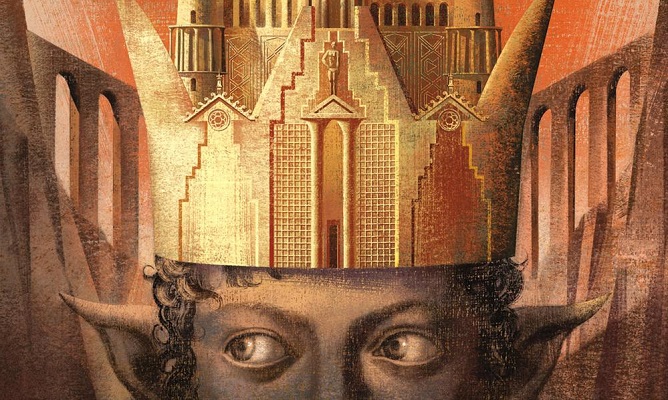Holy goblins, where do I even begin?
If you’re looking for high fantasy and science fiction blended with lots of political intrigue, a phone book’s catalogue of characters, a deeply ornate and calibrated world, and a bit of steampunk and magic, then look no further than Katherine Addison’s The Goblin Emperor. And if all of what I just mentioned appeals to you, then you are in for a serious treat.
The Goblin Emperor opens with Maia, a half elvish, half goblin youth of eighteen discovering that his father, the Emperor of the Ethuveraz, has died along with the emperor’s three older sons aboard the airship, The Wisdom of Choharo. With this shocking bit of news delivered on the novel’s second page, Maia finds himself in the unique position of having the title of emperor foisted upon his head without so much as a preamble, for him or for us.
Confused, afraid, and more than a little timid, Maia is pushed into a world of politics, drafty halls, hundreds of courtiers and Parliament members, and stiff, brocade clothing, at a loss for what to do, how to behave, or whom to trust. Also thrown into the mix is the hatred he feels for his father, who cast him not so much as a glance after the death of his goblin mother, Chenelo, and who relegated him to the outer village of Endonomee, where he was under the protection and jurisdiction of a distant relative, who verbally abused Maia and treated him disgracefully. But Addison handles this information infiltration smoothly, artfully, and most importantly, interestingly. You’re placed in Maia’s shoes, feeling his discomfort at the pearl sticks and combs in his hair, suffering his confusing dreams and restless nights, and keeping dizzying amounts of information about the court in his head.
Aside from all the intricacies of Addison’s expert worldbuilding, its most important aspect is its characters. The long list includes Maia’s personal bodyguards, the pontificating Lord Counsellor, the widow empress, Maia’s relatives and servants, and the many lords and ladies of neighboring lands all under Maia’s jurisdiction. These characters make the book sing. They never get lost in the shuffle, but stand prominently in the center of it, focal points in a whirlwind of protocols and procedures. My favorite character by far, aside from Maia himself, is Csevet, Maia’s secretary, who behaves with the perfect blend of professionalism, sincerity, and compassion. You find him a loyal companion (and friend, even though he would find it unprofessional to admit it) to the new emperor, and the relationship he develops with Maia is one of affection that borders on friendship while also retaining its professionalism.
Although I did sometimes gloss over the mental pronunciation of names, that was due to my own reading laziness, and it’s clear Addison spent time and energy creating not only the linguistic uniqueness of courtly protocol (the use of the formal “we” for self-address rather than the informal “I”, for example), but also the suffixes that determine relationship status and gender of each of her courtly characters. She’s also tactful and wise about who she introduces when; each chapter carefully adds another layer to the intricacies of courtly life and Maia’s roles and responsibilities, from arranging a funeral and performing in his own coronation, to choosing an empress.
All that said, if you’re turned off by long or strange names and confusing pronouns, this might not be the book for you. You might also want to steer clear if you don’t like any pomp and circumstance interspersed with your fantasy. Also on the downside, the elements of magic, which was really more religious mysticism, are few and understated, which didn’t bother me but might not be for you if you’re expecting something fantastical.
Overall, I think The Goblin Emperor is worthy of a Hugo nomination because it was unlike anything I’d ever read before in the fantasy genre. I haven’t read any of Addison’s other books so I’m not sure how it stacks up against her other works or even if it’s her best book. But I will say this: The Goblin Emperor delivers a regal, classical fantasy feel, complete with feasts and dances, political schemes, and intricate mythology.
Featured image via io9.


